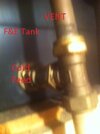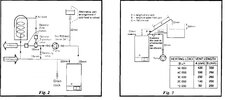- Joined
- 14 Feb 2011
- Messages
- 65
- Reaction score
- 1
- Country

Hi
I have a vented CH system consisting of 3 zones - up, down and HW only. Pump is a Groundfos 25 50 and has been operating without issue since at least 1993. The first radiator on both downstairs circuit and upstairs circuit both fill with air within a couple of weeks of bleeding and have done so for years. I’ve tested the gas in both radiators and am confident it is not hydrogen. My pump is on the return pipe about 1m from the boiler. In between the pump and the boiler is the water feed (1/2inch pipe) from f&e tank. My understanding is that this means that my radiators etc are all on the negative pressure side of the circuit and that this might be the reason for the build up of air in the system. The expansion pipe (1inch) is on the flow pipe about 4m from the boiler. I’ll be replacing the pump isolation valves shortly as both are leaking a little and I am wondering if this would be a good opportunity to convert to a close coupled system. If so does the requirement for a max separation of 150mm between the expansion and the feed pipes (both would be placed between boiler and pump on the flow pipe) apply only at the teeing position and can the two pipes follow different paths back up to the f&e tank?
Thanks in advance.
I have a vented CH system consisting of 3 zones - up, down and HW only. Pump is a Groundfos 25 50 and has been operating without issue since at least 1993. The first radiator on both downstairs circuit and upstairs circuit both fill with air within a couple of weeks of bleeding and have done so for years. I’ve tested the gas in both radiators and am confident it is not hydrogen. My pump is on the return pipe about 1m from the boiler. In between the pump and the boiler is the water feed (1/2inch pipe) from f&e tank. My understanding is that this means that my radiators etc are all on the negative pressure side of the circuit and that this might be the reason for the build up of air in the system. The expansion pipe (1inch) is on the flow pipe about 4m from the boiler. I’ll be replacing the pump isolation valves shortly as both are leaking a little and I am wondering if this would be a good opportunity to convert to a close coupled system. If so does the requirement for a max separation of 150mm between the expansion and the feed pipes (both would be placed between boiler and pump on the flow pipe) apply only at the teeing position and can the two pipes follow different paths back up to the f&e tank?
Thanks in advance.


